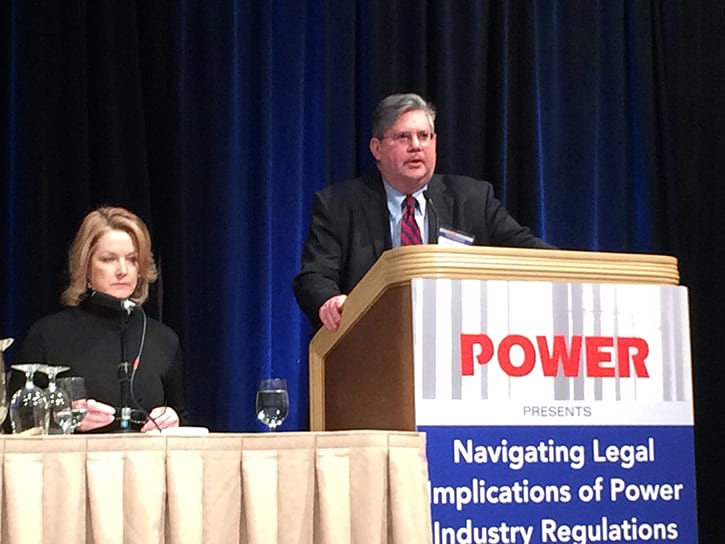Climate change litigation in the U.S. has far outpaced climate litigation in any other jurisdiction. In fact, according to Teri Donaldson, partner with DLA Piper, more lawsuits concerning climate change have been decided or settled in the U.S. than in the rest of the world combined.
“The success rate in these cases is very low,” said Donaldson, who was speaking at POWER’s conference on Navigating Legal Implications of Power Industry Regulations in Las Vegas, Nev., on Dec. 7.
“Climate change is pushing the courts to do things that the courts are not empowered to do and the courts are resisting that. They are declining to legislate, so the success rate internationally is about 40%,” she added.
Donaldson noted that one-sixth of all cases involved claims brought under the National Environmental Policy Act and most of the plaintiffs are environmental nongovernmental organizations. However, she also revealed that governmental entities are suing each other at a much more significant volume than has been seen in the past. One example is in cases filed as a result of the Clean Power Plan. Many states are weighing in either for or against the constitutionality of the rule.
Implementation Plans
Michael G. Cooke, of counsel with Greenberg Traurig, suggested that states need to focus on state implementation plans (SIPs) for the Clean Power Plan and not just litigation. As Avi Garbow, general counsel for the U.S. Environmental Protection Agency, pointed out during the event’s opening keynote speech, the Clean Power Plan is a final rule, so there is nothing uncertain about it.
States must submit SIPs by Sept. 6, 2016. A two-year extension can be requested, but annual progress reports are required and final SIPs must be submitted by Sept. 6, 2018. The initial compliance period begins on Jan. 1, 2022, with achievement of goals required by Jan. 1, 2030.
Cooke (Figure 1) examined the situations faced by two states, Maryland and Florida, to contrast their current circumstances.
 |
| 1. Teri Donaldson and Michael C. Cooke delivered presentations during a Dec. 7 conference in Las Vegas, Nev. Source: POWER/Gail Reitenbach |
Maryland deregulated its electricity market in 1998. It is a member of the Regional Greenhouse Gas Initiative—the first market-based regulatory program in the U.S. designed to reduce greenhouse gas emissions—which is a cooperative effort among the states of Connecticut, Delaware, Maine, Maryland, Massachusetts, New Hampshire, New York, Rhode Island, and Vermont. To comply with Clean Power Plan requirements, Maryland must reduce CO2 emissions by 37% by 2030.
Florida is a traditionally regulated state. It is essentially isolated on its own grid, with no independent system operator or regional transmission organization. Florida must reduce CO2 emissions by 25% by 2030 to comply with the Clean Power Plan.
Maryland Public Utilities Commissioner Kelly Speakes-Backman testified before the House of Representatives Energy and Power Subcommittee in support of the Clean Power Plan, while Florida Public Service Commission Chairman Art Graham challenged the rule during the same hearing on March 17.
Florida’s preliminary analysis suggested that significant coal-fired generation might have to be retired as a result of the rule and that capacity challenges could be created. It expected a continued shift to natural gas–fired generation, which already makes up 65% of the state’s energy mix. Some estimates predict natural gas will increase to as high as 85% by 2025, making the state very dependent on one type of fuel.
Maryland also expects the rule to result in the retirement of some coal capacity, but it expects to rely on a multistate trading approach with continued emphasis on renewable portfolio standards to address the challenge. Maryland has a much more diversified energy mix—44% coal, 38% nuclear, 9% natural gas, 5% hydro, 1% oil, and 3% other—so even with some change, it will be far less dependent on a single fuel source for its power.
Alarming Developments
“From the perspective of a former federal prosecutor, I am here to tell you what is going on in the securities side is insane. It’s out of control. It’s something that you do need to keep an eye on and be fearful of, in a way, because I’ve never seen anything quite like this,” Donaldson said.
She was referring to disclosures that the Securities and Exchange Commission (SEC) requires companies to make to shareholders. The commission issued guidance in 2010 on what a company should tell shareholders to expect as a result of climate change.
One thing the SEC pointed out is that much more information is publicly available outside of disclosure statements, but it also laid out expectations for companies to cover the impact of legislation and regulations in their annual report filings. In essence, companies are being asked to look into a crystal ball and guess what could happen in the future, with the possibility of being held responsible for inaccurate predictions.
“There are potential consequences that are not only expensive in terms of defending an investigation, but there is also the potential for criminal penalties for your inability to have an accurate crystal ball, and I think that’s really alarming,” Donaldson said.
Companies are expected to analyze the financial risks associated with expected trends in greenhouse gas (GHG) laws and regulations, and describe any climate change litigation that the company faces, which could have a material effect on finances. It must also analyze strategies to manage the risk, including stating its current position on climate change; estimating its GHG emissions for the reporting year; identifying expected GHG emissions from new plants that are subject to federal or state permitting; reporting ways it will adapt to the physical impacts of climate change; and addressing the company’s corporate governance process applicable to climate change issues, including the role of the board of directors and whether officer compensation is based on meeting climate change objectives.
Donaldson mentioned a recent article written by a Columbia law student who suggested that the Martin Act—which gives the New York state attorney general broad enforcement authority to bring both civil and criminal action without showing knowledge or intent to defraud—should be used to issue subpoenas and bring cases against companies.
“This is really surprising to me,” Donaldson said. “It really got my attention.”
With no adequate legal framework in place to combat climate change in the U.S., about all companies can do is keep fighting litigation that seeks to misuse the laws and the courts. Donaldson suggested that state and federal lawmakers must be pressed into action to do their jobs and pass suitable legislation.
—Aaron Larson, associate editor (@AaronL_Power, @POWERmagazine)









